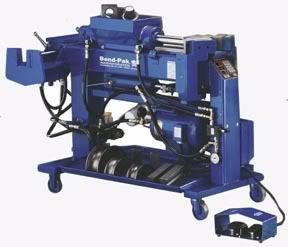johnnydmetal
Cast Iron
- Joined
- May 15, 2003
- Location
- Mine Hill,NJ,USA
Hi Guys
I haven't posted in a while I've been working my tail off here to get my small bussiness moving. I'm trying to put a Professional type mandrel bender together for less then a thousand dollars. This is primarily for bending exhaust tubing not heavy wall pipe. 3" or less, sometimes SS.
The first bender setup I put together didn't work well and just crushed the pipe. I basically took a brand new 25 ton log splitter as a base to work with and tried to do a ram type bender with two swing arms like this one here:

Also it bent the swing arms I had placed improperly.
So I had to go Back to the drawing Board. I looked at the Blind Chicken Bender a friend sent me this link to and I thought I might do that one.
http://www.blindchickenracing.com/Tools/Tube%20Bender/Tubingbender.htm
I kept searching and found this one which I think is a better fit to the log splitter design:
http://www.exm.netfirms.com/Bender/Diagrams.htm
and a whole discussion on building it here
http://www.pirate4x4.com/forum/showthread.php?t=185940&page=12
Its basically a JD2 Model 3 bender.
The JD2 does not bend 2 1/2" or 3" but I plan to make it a bit beefier to accommodate 3" bending Dies, so I can bend the 3" exhaust tubing.
What I am planning to do is instead of using 3/8 plate for the construction I want to cut out 1/2" and double it up making each piece now 1" thick. Then spend half the day drilling holes. The Pins used on the JD only cost about $10 for all of them but would likely be too short for the 1" plate. I was also concerned that 1" pins may not hold up to the stress of 3" bending.
I had made my first 2 1/2" die by stacking 3 plates with layers of plywood and running a drum sander through the curves:

I cant afford the machine I want right now and if I could I'd likely get a big 16" lathe and a Bridgeport vertical mill. It's in the neighborhood of $7-8000.
RMD Model 500-S
http://www.bii1.com/benders_b1b.htm
Anyway after all this explaining I was wondering if someone here could help with any recommendations for the pins.
Diameter of stock? Metal choice?
I have a SouthBend H10 I should be able to cut them without to much issue.
Thanks
John
I haven't posted in a while I've been working my tail off here to get my small bussiness moving. I'm trying to put a Professional type mandrel bender together for less then a thousand dollars. This is primarily for bending exhaust tubing not heavy wall pipe. 3" or less, sometimes SS.
The first bender setup I put together didn't work well and just crushed the pipe. I basically took a brand new 25 ton log splitter as a base to work with and tried to do a ram type bender with two swing arms like this one here:

Also it bent the swing arms I had placed improperly.
So I had to go Back to the drawing Board. I looked at the Blind Chicken Bender a friend sent me this link to and I thought I might do that one.
http://www.blindchickenracing.com/Tools/Tube%20Bender/Tubingbender.htm
I kept searching and found this one which I think is a better fit to the log splitter design:
http://www.exm.netfirms.com/Bender/Diagrams.htm
and a whole discussion on building it here
http://www.pirate4x4.com/forum/showthread.php?t=185940&page=12
Its basically a JD2 Model 3 bender.
The JD2 does not bend 2 1/2" or 3" but I plan to make it a bit beefier to accommodate 3" bending Dies, so I can bend the 3" exhaust tubing.
What I am planning to do is instead of using 3/8 plate for the construction I want to cut out 1/2" and double it up making each piece now 1" thick. Then spend half the day drilling holes. The Pins used on the JD only cost about $10 for all of them but would likely be too short for the 1" plate. I was also concerned that 1" pins may not hold up to the stress of 3" bending.
I had made my first 2 1/2" die by stacking 3 plates with layers of plywood and running a drum sander through the curves:

I cant afford the machine I want right now and if I could I'd likely get a big 16" lathe and a Bridgeport vertical mill. It's in the neighborhood of $7-8000.
RMD Model 500-S
http://www.bii1.com/benders_b1b.htm
Anyway after all this explaining I was wondering if someone here could help with any recommendations for the pins.
Diameter of stock? Metal choice?
I have a SouthBend H10 I should be able to cut them without to much issue.
Thanks
John



